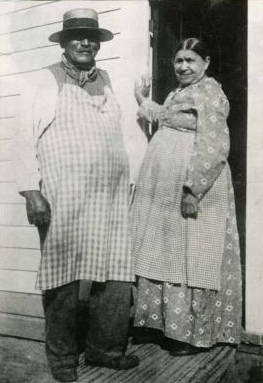George Speck facts for kids
Quick facts for kids
George Crum
|
|
|---|---|

George Speck with his sister "Aunt Kate" Wicks
|
|
| Born |
George Speck
July 15, 1824 |
| Died | July 22, 1914 (aged 90) Malta, New York, U.S.
|
| Occupation | Chef |
| Parent(s) | Abraham Speck, Diana Tull |
George Speck (also known as George Crum) was an American chef who lived from 1824 to 1914. He became famous for serving very thin, crispy fried potatoes at his restaurants. These tasty snacks were called "Saratoga chips."
Even though many people believe George Crum invented potato chips, recipes for similar fried potato slices existed long before he became a chef. However, the story of him inventing them became very popular. It was even used in big advertisements in the 1970s!
Contents
Who Was George Crum?
His Early Life
George Speck was born on July 15, 1824, in Saratoga County, New York. When he was young, he did not get the chance to go to school. This meant he did not receive a formal education.
Becoming a Chef
George Speck learned how to cook at a place called Cary Moon's Lake House. This restaurant was on Saratoga Lake. It was a very fancy and expensive place. Rich families from big cities like Manhattan would build summer homes nearby. George and his sister, Wicks, also cooked at another hotel called the Sans Souci.
By 1860, George Speck opened his very own restaurant. It was called Crum's and was located in Malta, New York. His cooking was very popular with tourists and important people visiting Saratoga Springs. People said his food was worth the high prices. He even grew many of his ingredients on his own small farm.
The Famous Potato Chip Story
George Speck's sister, Wicks, shared a story about how the "Saratoga Chips" were invented by accident. She said a small piece of potato accidentally fell into a pan of hot oil. She pulled it out and put it on a plate. Her brother, George, tasted it and loved it! He said, "We'll have plenty of these."
In 1932, Wicks's grandson, John Gilbert Freeman, told a newspaper that his grandmother, Wicks, was the real inventor of the potato chip.
Fun Facts About George Crum
- George Speck was a member of the Mohawk people.
- When he was younger, he worked as a hunter, a guide, and a cook in the Adirondack Mountains.
- A very important customer at Cary Moon's Lake House was a shipping businessman named Cornelius Vanderbilt. He often forgot George Speck's name. One time, he called George "Crum." Instead of being upset, George decided to use the nickname. He thought, "A crumb is bigger than a speck."
- Many stories say that George always put a basket of his famous chips on every table in his restaurant.
- In 1973, a company that made packaging for chips used George Speck's story in their advertisements. These ads appeared in popular magazines like Fortune and Time.

